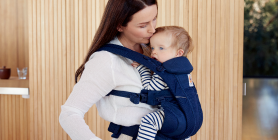
Back wearing, also known as Back Carrying, seems to elicit both interest and a little bit of fear from babywearing parents. While Back Carrying is one of the most liberating types of carries--it enables you to be hands-free and keep the baby safe from whatever you are doing--it seems to be one of the most daunting carries for parents. Carrying your baby on your back allows the parent to perform many tasks that would otherwise be difficult with a baby on the front. Of course, as with any carry, there are safety precautions, but when followed, the Back Carry can become an indispensable tool in the babywearer’s toolkit--grocery shopping, laundry, meal prep (put baby down when working with anything hot!), dishes, trips to the farmer’s market, for example--all become so much easier with the Back Carry! This is also an ideal carry for the baby to play or really observe the world around her. Historically, Back Carrying has been an essential part of life in many parts of the world. In many cultures, it allowed mothers to work while still tending to baby. Parents adapted the carry using a variety of materials, depending on the climate, the task at hand, and what was available to them. Thankfully today, back baby carriers such as the soft structured carrier (SSC) allow a simple and easy way for the parent to practice this carry. With SSC’s it is recommended that the Back Carry is the third carry you attempt, and only once the baby is able to sit up on his or her own. Because Back Carrying centers the baby on the parent’s hips, the weight is easier to bear. A soft structured carrier is ideal for a Back Carry, as it supports the baby’s legs in a natural seated position.
Tips for Back Carrying with the Ergobaby:
- To avoid injury when learning to place your baby in the carrier, do so over a bed or other cushioned surface or with the help of another person.
- Back baby carries should only be used when your baby has a strong and consistent head and neck control, and hips and legs open naturally into a spread position.
- Tighten shoulder straps to secure baby close to your body. If baby is hanging away from body or you feel it necessary to compensate for baby’s weight, then tighten shoulder straps more. But be sure not to over-tighten, baby should feel snug but still be able to move.
- Baby should be centered in the carrier. Some bouncing up and down, while pulling carefully on one leg and the opposite side of the carrier, can be helpful in adjusting baby’s position in carrier.
- If carrier seems to ride lower on baby’s back, pull up on shoulder straps and bounce slightly to encourage baby’s weight to fall farther towards the waist belt. This is very important: baby should be sitting fully in the pouch.
Ultimately, carrying your child will allow for extended bonding while allowing the parent the ability to manage and accomplish daily tasks, as well as venture to out into the world. Carrying your little one on your back, rather than on the front, at the farmer’s market for example, can be quite liberating. Imagine how much easier it will be to pick up that bag of oranges with your baby safely and securely on your back, while she is still able to take in all the sights and sounds around her! While babywearing allows for both closeness and mobility for the parent, the Back Carry can open up an entire world for both baby and parent. This story, written by Ergobaby, appeared in the May/June 2012 official newsletter of Babywearing International, of whom we are a proud sponsor. You can see the full version of the newsletter here.
Summer adventures with your baby are a wonderful way to create lasting memories and enjoy the beauty of nature together. From baby carriers to strollers, Ergobaby products are designed to provide comfort and ease for both you and your little one. So, gear up, get outside, and explore the world with your baby by your side.
Ready to embark on your own summer adventures? Check out Ergobaby’s range of baby carriers and strollers to find the perfect match for your family’s needs. Visit our website today and start planning your next outdoor excursion!
Emotional Benefits of Getting Outside
Spending time in nature with your baby can strengthen the bond between you. The simple act of holding your baby close, feeling their warmth, and sharing new experiences together can create strong emotional connections. It’s also a wonderful way to reduce stress and improve your mood. When my littles were extra fussy, I’d take a walk around the neighborhood. Even though I don't live in an area with trails and surrounded by nature, simply behind outside changed everything. A little vitamin D does wonders!
Cognitive Development
Nature is a sensory wonderland for babies. The different sights, sounds, and smells can stimulate your baby’s senses and promote cognitive development. Watching leaves rustle, hearing birds chirp, and feeling the texture of a tree bark can all contribute to their learning and development.
All About Baby Carriers for Nature Adventures
Choosing the Right Baby Carrier
When it comes to selecting the best baby carrier for summer adventures, there are several options to consider.
Types of Baby Carriers:
- Wraps: Perfect for newborns, providing a snug and secure fit.
- Slings: Ideal for quick and easy use, offering good ventilation.
- Soft Structured Carriers: Versatile and comfortable for both parent and baby, suitable for longer trips.
Factors to Consider:
- Baby’s Age and Weight: Ensure the carrier is appropriate for your baby’s size and weight. For example, Ergobaby’s Embrace Newborn Carrier is perfect for the fourth trimester where baby is small and you’re looking for an easy way to stay close. As they grow, you’ll want to upgrade to an all-position carrier that’s meant for growing babies.
- Parent’s Comfort and Ergonomics: Look for carriers with padded shoulder straps and lumbar support if you’re planning on longer outings.
- Ease of Use: Choose a carrier that is easy to put on and take off.
- Climate and Breathability: Opt for carriers made of breathable fabrics to keep you and your baby cool in hot weather.
Safety Tips:
- Proper Positioning: Ensure your baby is seated correctly, with their legs in an "M" position and their head should be close enough to kiss.
- Checking for Wear and Tear: Regularly inspect your carrier for any signs of damage.
- Ensuring Adequate Support: Make sure the carrier provides proper support for your baby’s head and neck.
Exploring Nature with a Baby Carrier
Ideal Spots for a Nature Walk with Baby
- Parks and Gardens: Great for leisurely walks and picnics.
- Nature Trails and Forests: Perfect for more adventurous outings.
- Beaches and Lakesides: Wonderful for enjoying the water and sand, with the right carrier.
Activity Ideas
- Hiking: Enjoy a scenic hike with a hiking baby carrier that offers support and storage.
- Bird Watching: Use your carrier to keep your baby close while you explore and observe wildlife.
- Picnics: A carrier can free up your hands, making it easier to carry picnic supplies.


Advantages of Using Strollers for Nature Adventures


While baby carriers are fantastic for mobility and closeness, depending on the adventure of choice you might want to be a stroller along too.
There are a LOT of baby stroller options on the market. So we understand how confusing it can be to choose the one that’s right for your family. Not only are there a variety of brands, but a variety of strollers that serve different purposes.
There are a few types of strollers on the market:
- Full-sized stroller: This is typically the stroller parents thing of buying for all its versatility.
- Lightweight or umbrella stroller:These compact strollers are perfect for on-the-go adventures.
- Jogging stroller: Designed for parents who want to combine fitness with outdoor adventures.
- Double stroller: Designed for parents with multiple kids, especially twins.
- Car seat carrier: These strollers connect to a specific car seat. We don't typically recommend these as they can be unsafe for baby and uncomfortable for parents who are pushing.
Learn more about the types of strollers and which one would be best for you.
Benefits of Bringing a Stroller
- Storage Space for Gear: Ample room for carrying all your essentials like a diaper bag, beach toys and more.
- Shade and Weather Protection: Built-in canopies to shield your baby from the sun when they are lounging.
- Options: If you have more than one kid, you can stroll with one and carry the other. Or, if you’re getting warm or your little one is getting fussy, you can switch up their position from stroller to carrier or vice versa.
Safety Tips for Strollers
- Ensure your stroller is in good working condition. Make sure buckles are still buckling and that there are no rips or holes that could compromise your baby’s safety.
- Use sunshades or bug nets to protect your little one’s skin.
- Securing the baby properly: always buckle up your baby for safety even if you think they are old enough to go without the buckle.
Combining Baby Carriers and Strollers
For the ultimate flexibility, consider using both a baby carrier and a stroller on your outings.
Combining both options allows you to adapt to different situations. Use the carrier for more rugged trails and switch to the stroller for smoother paths or when your baby needs a nap.
Transition Tips
- Smooth Transitions: Plan stops where you can easily switch from carrier to stroller.
- Pack Light: Only bring essentials to make transitions easier.
Tips for a Successful Adventure
Planning Ahead
- Route Planning: Choose baby-friendly trails and parks. Check local mom groups or outdoor groups and get recommendations for the best outings for kids.
- Check Weather Conditions: Avoid extreme heat or unpredictable weather. Even with our most breathable carriers, when it’s hot, it’s hot. And having two bodies against each other in the heat will be naturally hot and sticky already.
- Packing Checklist: Include diapers, snacks, water, sunscreen, and a first-aid kit. These all-position carriers have storage pockets where you can fit some of the items easily!
- Stay Hydrated and Nourished: Pack healthy snacks to keep energy levels up and bring plenty of water for both you and baby.


Summer adventures with your baby are a wonderful way to create lasting memories and enjoy the beauty of nature together. From baby carriers to strollers, Ergobaby products are designed to provide comfort and ease for both you and your little one. So, gear up, get outside, and explore the world with your baby by your side.
Ready to embark on your own summer adventures? Check out Ergobaby’s range of baby carriers and strollers to find the perfect match for your family’s needs. Visit our website today and start planning your next outdoor excursion!




























